Phoenix Boxing
What boxing experience can teach a karate-ka
By Christopher Caile
Author’s Note: The
author’s own concepts and observations about the differences between
boxing, karate and techniques within traditional Okinawan kata are added
to the article within the photo captions, Author’s Notes at the
end of the article, and occasionally within the text. They are not necessarily
shared by Phoenix Carnevale or Mike Smith.
|
Phoenix Carnevale angles off the center line
and hooks a punch into the floating ribs of the author, Chris Caile.
By angling and using an outside hook punch a boxer can get inside
the reach of a bigger opponent to strike from an angle that can
penetrate the defender’s arms if they are not well positioned. |
It was already 90 degrees outside by 9:00 in the morning when I walked
upstairs to Gleason’s Gym. Gleason’s, the world famous boxing
gym, is on the second floor of a commercial building sitting virtually
under the end of the Brooklyn Bridge in Brooklyn, NY.
As I entered I could see about 30 people training in a large unobstructed
room scattered with boxing rings.
There was the pop, pop of gloves hitting into bags, and the steady tick
of jump ropes hitting the floor in regular cadence. Others were shadow
boxing, and in several rings trainers were holding up target mitts for
fighters to hit.
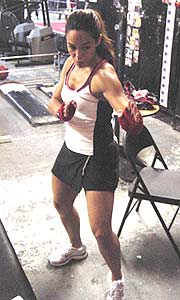 |
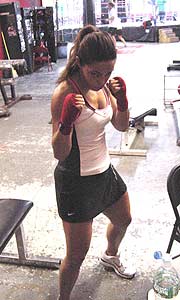 |
In a karate fighting stance (left)
Phoenix's body is angled almost sideways (about 80 degrees), one
leg behind the other, with the body more open and her hands lower,
the left hand extended forward. The stance, while stable, is best
positioned for forward and back movement, but not so for movement
to the side. Likewise her hands and arms are not positioned to effectively
block head strikes, but can easily be used to counter a variety
of kicks. Many point fighters turn there body even further to the
side to protect their target area, but if they are participating
in semi contact sparing their stance is more like a boxer. In a
boxing stance (right), Phoenix's body angle is more like 45-55 degrees,
allowing for movement in any direction. During boxing the stance
is also very flexible and is adjusted to need. Her hands are also
held higher protecting her head, while the forearms protect the
ribs on both sides. |
I was there to talk to Phoenix Carnevale, a Seido Karate student, and
a kick boxing and fitness teacher, who is training for the New York City
Golden Gloves championship. I found her in a back corner of the gym with
her trainer, Mike Smith. Mike is the gym’s mixed martial arts stand-up
coach. He is a former Oyama Karate student, who in addition to boxing
also regularly trains in Machaddo Brazilian Jujutsu. At the gym he has
worked with such notables as the Gracies and members of the International
Fight League.
|
Mike and Phoenix jockeying for position in the
ring. Each constantly moves, circles, angles and adjusts against
the other, trying to get positional advantage, create an opening
or elude the techniques of the other. Developing this type of fluid
body movement can be very helpful to any karate-ka to help them
avoid attacks instead of just relying on blocking. Success and failure
depend upon who achieves the better positioning and wins the fight
to control the space between them. Most modern day karate fighters
in free fighting and competition use the same tactics, but old style
Okinawan kata taught a different principle: Using blocks, grabs,
strikes to nerve points, off balancing and other techniques to take
control of the opponent’s body and thus his actions in order
to counter. (1) |
|
Boxers live in a close-in tumble
world of arms length punches, hard blows and counters. It can be
brutal. Modern day Karate-ka most often spar at a greater distance
where arms don’t reach the opponent unless there is movement,
but kicks do. Taekwondo practitioners fight at even a farther distance
relying primarily on leg techniques. Both are usually very uncomfortable
with close-in fighting. They are not used to it and feel uncomfortable.
In addition they are not used to really getting hit, unless they
are from a semi contact style or are involved in mixed martial arts.
Interestingly, however, old style Okinawan karate kata includes
close in self-defense and combat techniques. |
I asked them to comment on the difference between karate free fighting
and boxing, especially in the use of the hands. Mike commented that all
martial arts have core principles, “but in boxing the fighter is
doing it for a living. The fighter gets to test what he is doing, then
make adjustments. They do this all in real time against a partner who
is trying to hit them. “Thus the real difference,” Mike said,
“is that boxers have real time experience and constant training.
They also get feedback when they do things wrong.”
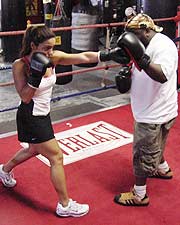 |
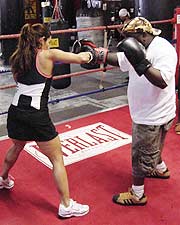 |
As her trainer Mike Smith moves around
the ring, Phoenix Carnevale moves to follow, hitting a hand held
target mitt with a left punch and right cross, constantly adjusting
to Mike’s movement. This allows her to develop her techniques
within a dynamic, moving environment. While traditional karate kata
always included movement with striking, modern karate classes often
drill punches from static positions. This tendency tends to slow
the karate-ka’s development and coordination of movement (and
adjustment) with punches (or kicks), something which is critical
to effective sparring. (2) |
“What this means in my training,” said Phoenix, “is
fluidity.” She noted that when she started boxing, she was really
tight and not relaxed and fluid. “In karate, especially in kata,
we assume rather ridged positions and when we punch, the punch is often
held out extended. Against a boxer, if I kept my arm extended, it would
be quickly picked up and would invite a counter to my face. Not good.”
(3)
 |
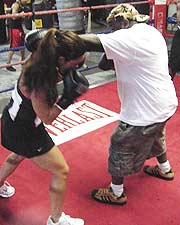 |
Phoenix positions her body and slightly
moves her head to slip right and left punches from Mike. Moving
the head to avoid a punch is faster than intercepting a punch with
an arm block in karate. This is because once a defender sees an
attack coming (visual perception), the muscles of the neck can be
moved more quickly than the arm (they are closer to the brain, movement
is smaller and reflexive), rather than being dependent on spatial
judgment as to range and interception angle (used with arm blocks).
But there is a disadvantage too – the attack is avoided but
not interrupted. A second attack can follow. |
“My dad always told me to take up karate,” Phoenix added,
“but he also said box too.” Boxing, especially sparring, builds
up an expertise in timing and distancing, and teaches you to move your
body and head. You can get some of this too in karate free fighting, but
it is very different when you are getting hit and the opponent isn’t
kicking from a distance but is instead hitting for your head. (4)
In karate practice, Mike noted, you punch, kick and block in groups,
usually lined up, and practice these moves from a static position. You
don’t get the movement and footwork of movement from which to do
these techniques.
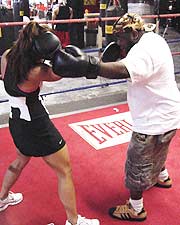 |
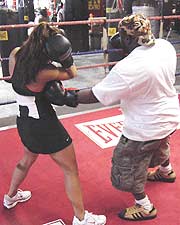 |
To create an opening for a punch,
Mike Smith angles to the left off the center line of Phoenix Carnevale
and executes a left hook to her head. The natural reaction is to
lift the arms, creating a gap underneath and to the side. This technique
is immediately followed by a second left hook to the exposed ribs.
Mike noted that a hook to the ribs alone probably wouldn’t
be successful. “You need the first technique,” he said,
“to set up the second.” Karate students are taught straighter,
more direct punching. Many, however, do adopt boxing-like hooks
and angular movement. On the street, however, the straight karate
punch can be surprisingly effective. It doesn’t provide many
visual clues to its use, and it is direct, fast and powerful. And
unless trained, many attackers won’t recognize what is happening
until too late. (5) |
Boxing, Phoenix said, is a martial art just like karate. Nike agreed.
“But don’t get confused,” he added, “Boxing is
not for street self-defense or combat. On the street you are just as likely
to get ambushed from behind with a weapon. And attackers often come in
groups. On the street, people don’t match off. “If you aren’t
careful someone will hit you from behind with something. And if there
is a knife, you often won’t see it until you are cut.”
Boxing is instead based on one-on-one with rules,” Mike added.
He also advises students not to strike with a fist to the face or head
if in a street fight. He has seen too many hands broken that way. For
him the effective head strike is done with the palm of the hand. Karate,
however, does often contain self-defenses against holds and grabs, he
noted, something not allowed or practiced in boxing.
“Another big advantage boxers have is conditioning,” Phoenix
noted. When she first started Mike tested her, having her do 10 rounds.
“He kept telling me to relax and breathe in through my nose,”
she said.
“You need more work on this,” Mike kept saying. He used an
old martial arts term, “kime.” Phoenix was puzzled. When she
asked, “What’s that?” Mike said to ask her karate teacher,
Kaicho Tadashi Nakamura (founder of the Seido World Karate Organization)
about the term. Nakamura is famous as a fighter. As a student of Mas Oyama
(Kyokushin) is the early 1960s as part of a three-man team in a challenge
match with Thailand, he beat the Thai lightweight full contact champion.
(Thai fighters not only use their fists, but knees and elbows too in addition
to powerful low kicks to the legs and thighs). He was the perfect person
to ask.
Phoenix said that Nakamura sat down and talked to her for quite a while.
But what he said was very different from what she expected. Explanations
of “Kime” usually refer to the focus of physical and psychological
forces into the point of contact (strike point). In physical terms this
refers to the sequential powering of legs, hips, trunk and arms as a coordinated
unit to maximum arm speed. Karate practitioners are often also taught
to momentary tighten at the moment of contact to add body mass behind
the fist (or other striking body part) to maximize impact and penetration.
Later in the week I asked Kaicho about what he said to Phoenix (Kaicho
Nakamura is also my teacher). He said that he provided a broader explanation
than what most associate with the word. He noted that Phoenix has a very
focused personality and when fighting she is constantly on attack. “But
kime,” he noted, “requires a type of balance. To achieve a
focused attack, you also have to be relaxed physically and mentally. You
also have to pick your opportunities while focusing on the opponent. This
way you can see and anticipate your opponent and his attack and you can
respond more quickly and counter more powerfully – with concentrated,
focused power (kime).”
Kaicho also noted a secondary advantage. “This way you also preserve
your energy. You will not tire yourself out with constant tension and
expulsion of energy. And you will also be able to use that energy more
effectively when needed.”
“Kime implies its opposite. This is the bigger picture,”
said Kaicho
“For me that was hard to do,” said Phoenix, “but I
am working on it. My strength is my technique and the power of my punches,
so I have to learn to relax and pick my opportunities and not always be
on the attack.”
|
Phoenix demonstrates how the shoulder can be
lifted to protect the jaw. |
Phoenix is also working on her angles -- learning how to angle the body
(not keeping it square to the opponent), learning how to angle off the
center line, how to turn the body and lift the shoulder, to shed off blows
to the head, to shift and duck and slip – to avoid flurries of punches
that could overwhelm her.
“I’m not a big person and am usually shorter, with a shorter
reach, than my opponent,” Phoenix explained. “I can’t
go head to head. Instead I have to get inside or come at angles, any way
to overcome the reach or weight advantage of my opponent.”
The range used in boxing is very different from karate. “For the
most part, karate practitioners aren’t used to the close distance
that fighters use. They adjust further away for kicking. They also tend
not to protect their head, something that is vital in boxing.
“Most karate student only protect their body from punches,”
Phoenix added. “On the street they would be vulnerable. And they
don’t usually learn the skills of slipping head punches, ducking,
or weaving. Karate students should practice these skills.”
While boxers use just a few weapons (jab, straight punch, hook and upper
cut), they also often angle their upper bodies forward or to the side
along with angled positioning and hook punches to create avenues of attack.
Karate attacks are usually more direct and karate-ka not used to this
movement can find themselves vulnerable to these type attacks. (6)
Traditional karate practitioners usually keep the trunk vertical, moving
the whole body as a unit, and punches are more direct. Karate, however,
has more total weapons. Karate-ka can also grab, pull, sweep or trip (in
addition to kicks, knees and elbows) and techniques can also be used in
a variety of distances. Where a boxer might clinch to control an attack,
on the street a karate ka could employ an elbow, knee, foot stomp or head
butt. In this way karate is in some ways more flexible than boxing, but
within the range of a boxer, and limited to boxer tools, the boxer has
the advantage.
When asked about her training, Phoenix said it consists of three rounds
of shadow boxing, which often is fairly static in terms of footwork. This
is followed by three rounds in the ring with Mike, moving, punching and
reacting to his moves –building up her reflexes and reactions. Twice
a week she also spars and every day she does 45 minutes to an hour of
cardiovascular work. She adds periodic explosive weight training with
light weights. “With karate I used to take just a few one hour training
and sparring classes a week,” she said. “The intensity of
training and the conditioning are different.”
“Another difference between her boxing and karate training,”
Phoenix noted, “is that in boxing we learn to absorb punches, slip
them or roll off, rather than trying to block them as in karate. In boxing
you are also going to get hit, and you learn not to be startled by it
or lose your composure. It’s part of your training and conditioning.
In karate, training often does not include this aspect. Most karate practitioners
can’t continue if they really get hit. They aren’t trained
to take a punch.”
"I would like to add something here," Phoenix said. "Boxing
and karate each have their own techniques and rules. I love them both,
and both have there benefits. Boxing has something to teach the karate
student if he, or she is interested, and karate has added techniques,
such as kicking and close range elbows and knees, that could help a boxer
on the street."
I then asked Mike about working with Phoenix.
“I like to work with Phoenix,” Mike said. “She has
will power. She comes in every day, to practice, to train in her technique,
over and over. That is dedication. That is the really hard part.”
Author’s Notes:
(1) Boxers
use movement and positioning to elude their opponent’s attack
or to create an opening for attack. The strategy of karate, as found
in traditional kata (not usually point free fighting), is different.
While movement is used to avoid getting struck, it is just as important
to control the attack in order to interrupt the opponent’s movement
and limit further attacks. Thus instead of absorbing a punch with the
shoulder, arm or fist (with glove) as in boxing, traditional karate
kata teach how to simultaneously block and counter while controlling
the attacker’s body. This is combined with whole body movement.
In short, you take over control of the opponent. Thus an important strategy
of boxing is positioning, while in karate it is controlling. This does
not mean that a boxer doesn’t try to control his opponent. For
example, when in the ring a boxer I would almost always follow a jab
aimed at his head with a counter-jab to his opponent. This counter is
effective in interrupting the opponent’s secondary attack, such
as a follow up cross. Likewise movement and angling help gain control
since they are used to avoid or set up an attack. A boxer will also
clinch so as to tie up his opponent’s arms. This is a way of stopping
(controlling) the opponent’s attack. In karate, however, traditional
kata illustrate how blocking and countering can blossom into control
and positioning of the opponent’s body through his reflex responses
and loss of balance. This is a much more hands on approach.
(2) The problem with static
positioning is not just relegated to karate punching drills. In 1994
I accompanied my aikido teacher Roy Suenaka, founder of Wadokai-Aikido,
on a trip to Japan to work with and meet many of his old aikido buddies
who trained with him while studying with Morihei Ueshiba, the founder
of aikido, and Koichi Tohei, who was largely responsible for synthesizing
a coherent aikido curriculum while under Ueshiba. In many of the schools
(styles) we visited, students were taught to assume certain stances
and positions in response to specific attacks. While perhaps useful
in basic assimilation of techniques, it struck me as also inhibiting.
Instead, I said to myself, you should be able to defend yourself against
any attack using any defense chosen from whatever position you are in.
What these teachers where teaching was static positioning.
(3) Boxers use padded gloves
and often use a flurry of punches. They also avoid the most dangerous
targets such as the throat, neck, back of the head, eyes, etc. A karate
person if attacked will use his or her bare hands, and a powerful technique
if properly targeted can end the confrontation in a single counter attack.
In old style Okinawan Shorin-ryu karate an extended arm is also often
used with an open palm to block the opponent’s eye sight, or control
an arm, fist or shoulder, something not usually done in boxing. A boxer
will sometimes, however, jab to control an opponent, block eye sight
or to judge proper range.
(4) I remember vividly the
first time I sparred in a ring against another boxer. There was this
sudden rush of realization: “This guy is trying to take my head
off. “ At first you almost panic and go into defensive mode. Most
karate-ka when finding themselves in the middle of a real fight or attack
just are not used to the distance or violence. In order to be able to
use your karate technique, or boxing skills, you have to practice in
like circumstances. You should learn how to react to head punches, how
to absorb blows, how to respond to grabs and pushes, how to fight more
than one individual and how to fight from any position, especially with
hands down (as if talking). This position, it should be noted, is the
starting and ending position of all karate kata (although there are
various hand positions used within various kata).
(5) Being direct and coming
from the center, the punch can travel to the head straight on. This
type of punch does not provide a defender with the visual clues given
by looping or circular punching or the initial shoulder movement that
foretells a technique launch. Furthermore the human eye is attuned to
picking up movement on the periphery of vision. The straight punch to
the face does not provide this clue and unless practiced in picking
up this type of straight counter attack, the opponent can easily totally
miss initial signals of launch. In addition if the defender is close
to the attacker with his hands down, a reactive straight center counter
karate punch will most often move under the attacker’s circle
of vision which can be blocked (unless the head is tilted forward) by
the protrusion of the cheek bone that lies under and in front of the
eye socket.
About The Author:
Christopher Caile is the Founder and Editor-In-Chief of FightingArts.com.
He has been a student of the martial arts for over 50 years and a teacher
of karate since 1962. He is the author of over 300 articles and columns
on the martial arts and editor of several martial arts books. Over the
last 20 years he has conducts seminars on street self-defense to community
and student groups in both the United States and Canada. His seminars
topics also include his specialty areas of kata applications and joint
locks and other jujutsu-like techniques found within karate. Caile started
his martial arts career in judo. Then he added karate as a student of
Phil Koeppel in 1959. Caile introduced karate to Finland in 1960 and then
hitch-hiked eastward. In Japan (1961) he studied under Mas Oyama and later
in the US became a Kyokushinkai Branch Chief. In 1976 he followed Kaicho
Tadashi Nakamura when he formed Seido karate and is now a 6th degree black
belt (Sei Shihan) in that organization's honbu dojo (NYC). He is also
Sensei in Wadokai Aikido under Roy Suenaka Sensei. Other experience includes
diato-ryu aikijujutsu, Hakuho-Ryu Aiki-jujutsu, kenjutsu, kobudo, Shinto
Muso-ryu jodo, kobudo, boxing and several Chinese fighting arts including
Praying Mantis, Pak Mei (White Eyebrow), Wing Chun, Chin Na and Shuai
Chiao. He is also a student of Zen. A long-term student of one branch
of Traditional Chinese Medicine, Qigong, he is a personal disciple of
the qi gong master and teacher of acupuncture Dr. Zaiwen Shen (M.D., Ph.D.).
He holds an M.A. in International Relations from American University in
Washington D.C. and has traveled extensively through South and Southeast
Asia. He frequently returns to Japan and Okinawa to continue his studies
in the martial arts, their history and tradition. In his professional
life he has been a businessman, newspaper journalist, inventor and entrepreneur.
|